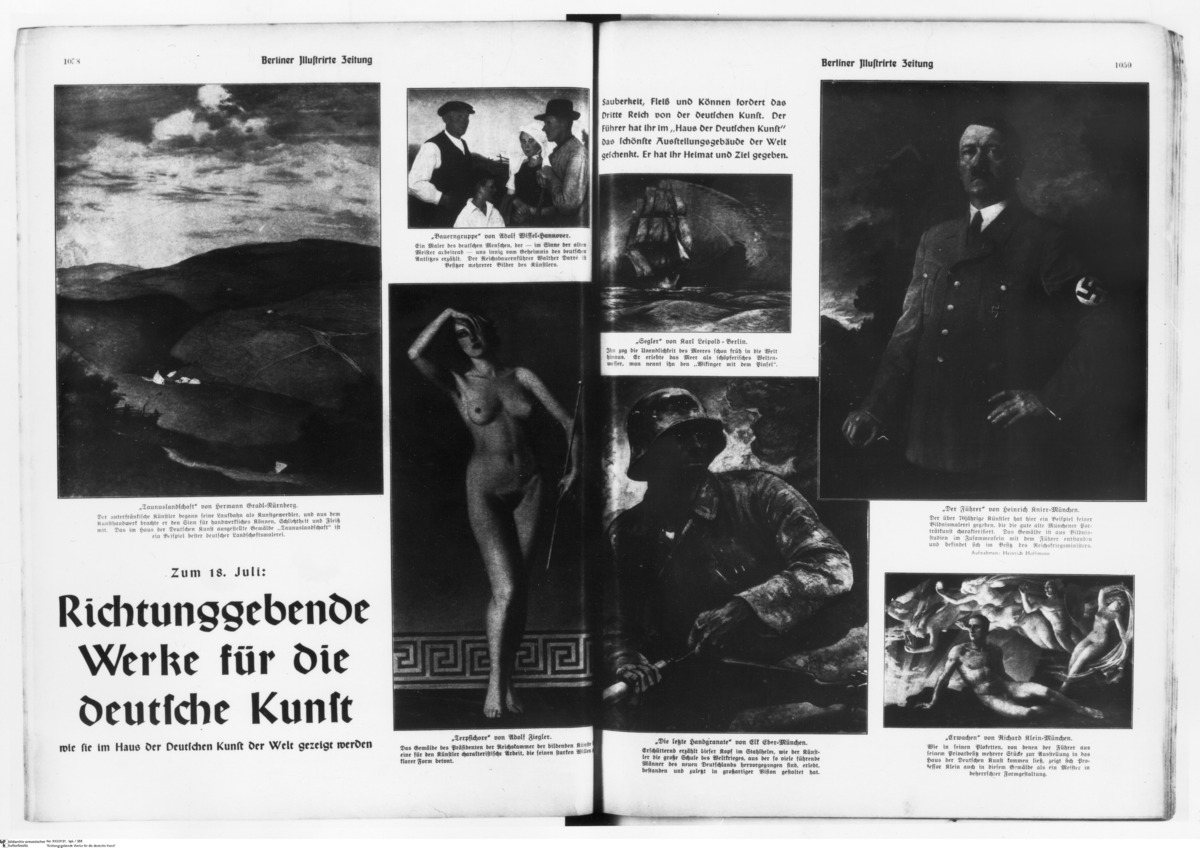On the day before the start of the “Degenerate Art” exhibition,
Hitler officially opened the “Great German Art Exhibition,” which was on
view in the House of German Art, a new museum designed by architect Paul
Ludwig Troost (1873-1934). It was the first of eight annual exhibitions
that aimed to define and display “German art.” The exhibited works were
chosen in an open competition; artists Adolf Ziegler, Arno Breker, and
Karl Albiker, all of whom were loyal to the regime, originally comprised
the jury for the 1937 show. A few weeks before the opening, however,
Hitler replaced them with his personal photographer Heinrich Hoffmann.
Approximately 900 works were exhibited. These included nudes, genre
scenes, still lifes, idealized landscapes, mythological scenes, images
of workers and heroes, and above all portraits of “pure” and “Aryan”
people.
The following illustrated report on the “Great German Art Exhibition”
appeared in the July 22, 1937, of the
Berliner llustrirte Zeitung
[Berlin Illustrated Newspaper]. As
the title suggests, the featured works, all of which were included in
the exhibition, were supposed to “set the direction of German art.” Each
illustration is accompanied by a caption praising it according to
Nationalist Socialist aesthetic and philosophical criteria. In terms of
visitor numbers, the “Great German Art Exhibition” was nowhere near as
successful as the “Degenerate Art” exhibition: during its four-month
run, it drew an average of 3,200 visitors a day, whereas the “negative”
show drew an average of more than 20,000 visitors a day during its time
in Munich. Illustrations and Captions
Left page:
“Taunus Landscape” by Hermann Gradl (Nürnberg) (left)
This
artist from Lower Franconia began his career as a craftsman, and the
arts and crafts gave him his sense for craftsmanship, simplicity, and
industriousness. The painting on display in the House of German Art,
“Taunus Landscape,” is an example of the best that German landscape
painting has to offer.
“Group of Famers“ by Adolf Wissel (Hannover) (right, top)
A
painter of Germans, who – working in the spirit of the Old Masters –
tells us the secrets hidden beneath the surface of the German
countenance. Reich Farm Leader Walther Darré owns several paintings by
the artist.
“Terpsichore” by Adolf Ziegler (right, bottom)
This painting by
the President of the Reich Chamber of Visual Arts is one of the artist’s
characteristic works; it emphasizes his strong will to clear form.
Right page:
“Sailor” by Karl Leipold (Berlin) (left, top)
From early on, the
endlessness of the sea drew him out into the world. He experienced the
sea as the creative water of the world; they call him the “Viking with a
Paintbrush.”
“The Last Hand Grenade” by Elk Eber (Munich) (left, bottom)
This
head in a steel helmet is a shattering testimony to how the artist
experienced and endured the great school of the First World War – out of
which so many leading men of the new Germany emerged – and how he
finally shaped it into a grand vision.
“The Führer” by Heinrich Knirr (München) (right, top)
The
septuagenarian artist has provided an example of his portrait painting,
which characterizes the good old Munich style of portrait art. The
painting developed from portrait studies during sessions with the Führer
and is now owned by the Reich Minister of War.
“Awakening" by Richard Klein (Munich) (right, bottom)
As
with his plaques, many of which were lent to the exhibition in the House
of German Art from the Führer’s private collection, this painting by
Professor Klein also shows him to be a master of controlled form.
